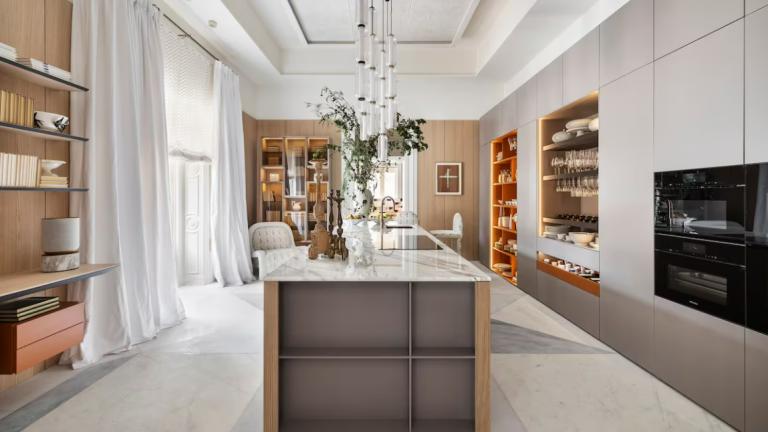Marble has been synonymous with luxury and craftsmanship for centuries, its luminous surfaces gracing palaces, historic homes, and artisan workshops long before it became a modern kitchen staple. In the kitchens of the Medici palaces, thick slabs of marble covered walls, floors, and counters, offering both beauty and practicality. During the Victorian era, bakers prized its smooth, cool surface for pastry-making, while butchers favored it for its ability to keep food fresh. Even today, Madrid’s old bars stand as proof of its endurance—Macáel marble counters, polished by decades of glasses, spills, and customers, have only grown more beautiful with time.
Despite its fragility, cost, and the meticulous care it requires, marble remains a coveted material in contemporary interior design. Many designers see it not only as a mark of refinement but also as a cultural artifact. The design studio Casa Josephine, celebrated for their work in Madrid’s Huertas neighborhood, continues to champion marble’s use in kitchens. In their renovation for illustrator Silja Goetz, they installed a Macáel marble countertop that serves as a visual centerpiece, contrasting elegantly with burgundy tones. “Marble is deeply ingrained in Spanish visual culture,” explains co-founder Pablo López Navarro. “We love it not just for its aesthetics but also for its history—it’s a material we grew up seeing in bars and shops.”
Raúl Martins, another leading designer, shares this appreciation, emphasizing marble’s uniqueness. His Casa Decor kitchen project featured custom flooring by Pardo Stone Design and drew inspiration from the opulence of Sicilian palaces. For Martins, marble’s charm lies in its individuality: “We are tired of repetitive, mass-produced finishes. A marble slab, hand-cut by an artisan, with its distinctive veins and textures, becomes a work of art—an expression of authenticity.”
Historically, civilizations from Mesopotamia to Greece and Rome valued marble for its versatility and sophistication, a sentiment revived during the Renaissance. Today, it’s celebrated for being warm and dynamic, its appearance shifting with the light. Martins advises homeowners to carefully select slabs, prioritizing interesting veining and durable varieties high in quartz to ensure longevity. Harder marbles are ideal for countertops and high-use areas, while softer, porous stones work best as vertical accents or decorative features.
Other designers are equally devoted to marble’s timelessness. The Madrid-based studio Galan Sobrini used marble extensively in a luxury apartment renovation on Calle Lagasca, applying it to cabinetry, countertops, and backsplashes. “Marble adds elegance and value to a kitchen, a room often overlooked,” say founders Adriana Arranz Sobrini and Cristina Chaves Galán. “It’s a noble material that ages gracefully, never going out of style.”
Mexican architect Jean Porsche echoes this sentiment. In his design for a 400-square-meter home in Salamanca, he boldly incorporated marble into every element of the kitchen, from the black-and-white striped floor to the Calacatta Boheme Vintage countertops and even the cabinet handles. “For luxury projects, nothing competes with natural stone. It always wins,” Porsche affirms.
However, marble’s beauty comes with responsibility. Designers caution that porous stones like travertine require sealing and careful maintenance to prevent staining, and acidic substances like lemon juice or vinegar can etch its surface if left unattended. Yet some enthusiasts embrace this patina, seeing wear as part of marble’s evolving character. As Porsche notes, “Stone is for life. It doesn’t fade and, with care, it only grows more beautiful.”
For those seeking alternatives, quartz and granite offer durability, scratch resistance, and low maintenance. Designer Erico Navazo acknowledges the popularity of these materials but remains loyal to marble, using it in his own kitchen. “Quartz and granite are practical,” he says, “but marble has unmatched elegance and natural beauty. If you’re willing to care for it, it’s worth it.”
Modern sealants and protective treatments have made marble easier to maintain, and studios like Casa Josephine emphasize that upkeep is simpler than many assume: avoid harsh acids, use cutting boards, and clean spills promptly. Over time, minor marks and stains fade, adding character rather than diminishing its appeal.
Ultimately, marble’s enduring popularity stems from more than aesthetics; it carries history, craftsmanship, and a sense of permanence. In an age dominated by mass production, marble offers individuality—no two slabs are identical. Whether featured in minimalist kitchens or dramatic statement spaces, marble remains a symbol of elegance and authenticity.
Its continued reign, despite high cost and upkeep, speaks to its irreplaceable role in design. Marble isn’t just a material; it’s an investment in artistry, one that transforms kitchens into timeless, lived-in spaces that tell a story with every vein and imperfection.

